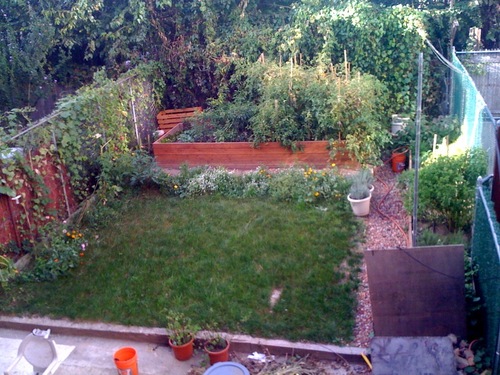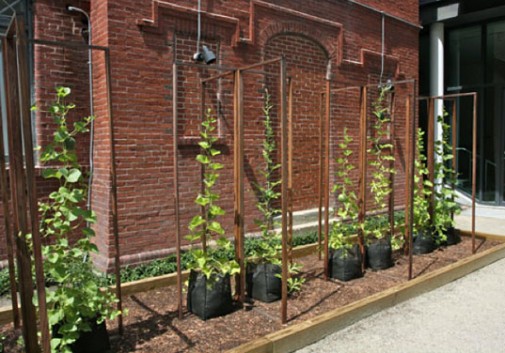Resources
What is Food Urbanism?
Upcoming events
You don't have access to any upcoming eventsSearch
Support

- FUI is supported by a grant from the Swiss National Science Foundation under the National Research Programme NRP 65 "New Urban Quality"
Typology >Site vacant sous-utilisé
Description
Créés ou nés de la disparition d’un usage ou d’un bâtiment, ces espaces sont la plupart du temps laissés à eux-mêmes. Ils sont généralement entourés des bâtiments restants et ont au minimum une face donnant sur une voie de communication. Dans l’attente d’une réappropriation ou réutilisation de ces espaces, un certain nombre d’initiatives spontanées peuvent voir le jour, mais toujours de manière éphémère. Historiquement une partie des parcs urbains sont nés de la destruction de grandes infrastructures de protection telles que remparts et glacis.
Contexte urbain
Dans le contexte urbain actuel, peu d’espaces restent inutilisés pendant une longue période. Souvent utilisés comme surfaces de parking sauvage ou comme lieux de production spontanée, ils partagent ces fonctions avec d’autres usages moins souhaités tels que des espaces de dépôts, voire de décharge. Ces sites sont particulièrement aptes à la mise en place d’éléments de production spontanée ; la mise en place d’un élément pérenne et public ne sera possible qu’avec l’accord du propriétaire.
Composante environnementale
Tout comme les autres surfaces de friche, ces surfaces agissent dans le milieu urbain comme des zones de réserve de végétation. Elles sont principalement dominées par une végétation dite pionnière, qui laisse place avec le temps à une végétation plus stable et plus variée.
Possibilités
Disponibilité du terrain immédiate.
Facilité d’accès au terrain.
Revalorisation d’un espace laissé à l’abandon.
Création d’un état de transition.
Visibilité moindre peut être propice à des initiatives plus spontanées.
Investissement de départ peu important.
Vivifier le sentiment de liberté dans la ville.
Contraintes
Difficulté d’établir une installation professionnelle.
Travail de préparation du terrain important.
Peu ou pas de terre de culture, besoin d’importer des matériaux.
Terrain de culture difficile (sécheresse, terrain pollué).
Pérennité du projet incertaine.
Where do your vegees come from ?

Where do your vegetables come from? In big cities people tend to forget where and how food is produced. The installation was an effort to bring together food consumption and production in a simple direct way. The aim of the …
+ read more
Idroponia

Idroponia in aulide
Matera. italy
A model in 1:1 scale hydroponic urban agriculture has been designed and built next to a house in the Sassi Area of Matera ( Basilicata, South Italy ). Hydroponics is a growing technique that uses …
+ read more
Edible Campus – The University of Quebec, Montreal

Campus Comestibles is a set of four initiatives for four university campuses. Montreal students are working hard to promote urban agriculture and eventually be able to feed themselves thanks to the university’s production. The University of Quebec in Montreal (UQAM) …
+ read more
Inuvik Community Greenhouse

The Inuvik Community Greenhouse is the most northern greenhouse in North America located just above the 68th parallel, roughly 2 degrees north of the Arctic Circle. It is home to the Community Garden Society of Inuvik – a non-profit organization …
+ read more
Artscape Wychwood Barns

Adaptive reuse projects maintain connections to our past while conserving resources through the reuse of materials. Depending on location and use, they can also benefit communities by revitalizing neighborhoods. The Artscape Wychwood Barns project in Toronto is one such case. …
+ read more
“Le jardin des amis de Thônex”

Since 2005, the non-profit organisation Equiterre (Equiterre – Partner for sustainable development) promotes the development of urban gardens in the heart of neighbourhoods on unused land through its project “Potager Urbain” (with the support of the Loterie Romande). Equiterre supports …
+ read more
Le 56 – Ecointerstice

‘Le 56′ is located on a formerly unused piece of land which had remained undeveloped due to outstanding conflicts between building developers and the municipality. In an attempt to resolve the issue, the commune of Paris invited Atelier d’Architecture Autogérée …
+ read more
Franklin permaculture garden

The UMass Permaculture Initiative is a unique sustainability program that converts unproductive grass lawns on campus into ecological, socially responsible, and financially sustainable permaculture landscapes that are easy to replicate. The permaculture garden provides food for the campus dining facilities …
+ read more
Incredible edible

Incredible Edible is a campaign group for local food in an ex-industrial Yorkshire market town. They support and encourage a number of food related projects throughout the town some of which are located in unconventional locations such as the graveyard …
+ read more
Growing Power

The mission of Growing power is “to grow food, to grow minds, and to grow community.” Focusing its efforts on underserved urban neighborhoods, Growing Power strives to increase access to local food, education and training, and economic opportunity.
Its production …
+ read more
Farming the City

FarmingtheCity.net maps and showcases an initial 20 key city farming projects on an interactive online site. Case study information includes location, type of project (commercial, community, innovation), status (start-up, on-going, completed) and position within the developing local food system (sourcing, …
+ read more
Growing Power Vertical Farm

The vertical farm will expand and improve Growing Power’s greenhouse and aquaponics operations currently spread over a two-acre site located in the City of Milwaukee. Five stories of south-facing greenhouse will allow the production of plants, vegetables, and herbs year-round. …
+ read more
Farm-Fresh Foods in Vending Machines

The Peter-und-Paul-Hof farm teamed up with the vending machine manufacturer Stuewer to dispense farm-fresh produce, including eggs, milk, cheese and sausage. Theses vending machines are located in thirteen nearby German towns in order to increase availability of such products to …
+ read more
Edible Public Space

Edible Public Space is an experimental project of food growing in public space in Leeds. The Edible Public Space is based on providing resources for cheap and healthy food allocation within disadvantaged neighborhoods; bringing back an essential element in life …
+ read more
EcoBox

“ECObox is a temporary garden constructed out of recycled materials”. It is a series of self-managed projects in the La Chapelle area of northern Paris which encourage residents to get access to and critically transform temporary misused or underused spaces. …
+ read more
Brick City Urban Farms and EarthBoxes

Brick City Urban Farms began using EarthBoxes when they created an urban farm (with the help of the newly elected mayor) on an unused parcel of land in Newark. The soil on this plot was polluted and unsuitable for growing …
+ read more
Community Vehicular Reclamation Project

A car towed from the junkyard was filled with soil, the body work painted, planted with herbs, flower and vegetables then parked up on the street in the Kensington Market area of Toronto. This installation was one of the many …
+ read more
City Farm

City Farm is the most recent initiative of the Resource Center. The farm turns fallow, vacant land into amazingly productive farmland. The benefits are tangible: instead of an acre of crumbling cement and overgrown weeds they have created a viable …
+ read more
Greenport Venlo “fresh food and business park”

Fresh Park Venlo is a fresh & food business park compromising of a clustering of companies and suppliers, from growers to transport companies, from traders to packing companies and from bulk to ready-to-cook fresh products.
The business park has ideal …
+ read more
Hantz Farms Detroit

Hantz Farms Detroit aims to create the world’s largest urban farm. As Detroits population and economy have declined over the years, much of the city is vacant or dispersed across the city limits. John Hantz sees urban agriculture as a …
+ read more
Tenth Acre Farms

The Tenth Acre farm started in a backyard, where large raised beds were constructed. The farm soon expanded onto an unused basketball court at a nearby church. The farmers use a CSA and market stall to disribute their produce.
The …
+ read more
n55 City Farming Plant Modules Manual

The City farming plant module is an inexpensive method to create floating plant modules using off the shelf products. Using a semi-permeable cloth, soil and a soaker hose; modular planting units can be arranged however is desired, as long as …
+ read more
Alemany Farms

Alemany Farms is a volunteer-run farm set between residential areas, playfields and a highway. There are in-ground plantings, raised beds, hoop houses, and areas for educational groups to gather.
The Alemany Farm is a non-profit organization which uses the farm …
+ read more
Union Street Orchard

The Union Street Orchard was a temporary installation of floating and in-ground agriculture. It’s construction was part of the London Festival of Architecture and transformed a parking lot in the SE1 neighborhood of London into an urban orchard and community …
+ read more
SWOMP 4

Residents opposed the demolition of a building and the cutting down of trees on the property, in preparation for the building of a school. They organized and decided to use the site for a permaculture garden that is managed seasonally …
+ read more
Sharecropper NYC Micro Farming

Artist Leah Gauthier began exploring how people interact with food by building small pots from seed packages and distributing them around NYC. The artist is now using organic growing methods to plant rare and endangered heirloom vegetables and herbs, and …
+ read more
Hen Park: NYC Parking day 2009

With the ongoing efforts in New York to combat hunger and poor nutrition among residents and to increase access to healthy foods, Hen PARK encourages New York residents to leave a space in their heart and in their designer handbags …
+ read more
Chef’s Farm

The “Chef’s Farm” is a small hydroponic greenhouse that can be installed in a restaurant and can produce 20,000 heads of lettuce per year. It fits into a kitchen and it supplies fresh vegetables on command with the utmost convenience.…
+ read more



